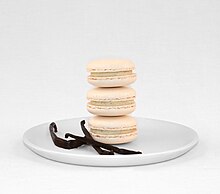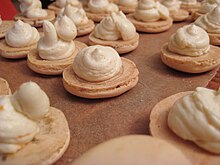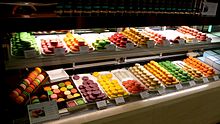Macaron: Difference between revisions
ClueBot NG (talk | contribs) m Reverting possible vandalism by 192.30.95.22 to version by 195.194.125.105. Report False Positive? Thanks, ClueBot NG. (3221961) (Bot) |
|||
| Line 66: | Line 66: | ||
===Swiss=== |
===Swiss=== |
||
In [[Switzerland]], the Luxemburgerli (also Luxembourger) is a brand name of [[confectionery]] made by the [[Confiserie Sprüngli]] in [[Zürich]], [[Switzerland]]. A Luxemburgerli is a macaron<ref>{{cite web|last=Hubbeling|first=Christina|title=Wer macht die besten Macarons? (Who makes the best macarons?)|url=http://www.nzz.ch/aktuell/startseite/wer-macht-die-besten-mac-a-rons-1.3878825|work=Neue Zürcher Zeitung|publisher=Neue Zürcher Zeitung AG|accessdate=3 March 2014}}</ref><ref>{{cite web|last=Böhler|first=Guido|title=Macarons: wer macht die besten und schönsten? (Macarons: who makes the best and most attractive ones?)|url=http://www.delikatessenschweiz.ch/index.php?db=delireport&nr=136|work=delikatessenschweiz.ch|publisher=foodaktuell.ch|accessdate=3 March 2014}}</ref> comprising two disks of almond meringue<ref>{{cite web|last=Malgieri|first=Nick|title=Baking : How to Make a Macaroon|url=http://articles.latimes.com/1994-07-21/food/fo-18003_1_almond-paste|work=Los Angeles Times|accessdate=3 March 2014}}</ref> with a buttercream filling.<ref>{{cite web|last=Kummer|first=Corby|title=Smackaroon! The Switzerland vs. France Cookie Smackdown|url=https://www.theatlantic.com/health/archive/2011/03/smackaroon-the-switzerland-vs-france-cookie-smackdown/73211/|work=The Atlantic|publisher=The Atlantic Monthly Group|accessdate=3 March 2014}}</ref> Luxemburgerli are smaller and lighter than macarons from many other vendors. |
In [[Switzerland]], the Luxemburgerli (also Luxembourger) is a brand name of [[confectionery]] made by the [[Confiserie Sprüngli]] in [[Zürich]], [[Switzerland]]. A Luxemburgerli is a macaron<ref>{{cite web|last=Hubbeling|first=Christina|title=Wer macht die besten Macarons? (Who makes the best macarons?)|url=http://www.nzz.ch/aktuell/startseite/wer-macht-die-besten-mac-a-rons-1.3878825|work=Neue Zürcher Zeitung|publisher=Neue Zürcher Zeitung AG|accessdate=3 March 2014}}</ref><ref>{{cite web|last=Böhler|first=Guido|title=Macarons: wer macht die besten und schönsten? (Macarons: who makes the best and most attractive ones?)|url=http://www.delikatessenschweiz.ch/index.php?db=delireport&nr=136|work=delikatessenschweiz.ch|publisher=foodaktuell.ch|accessdate=3 March 2014}}</ref> comprising two disks of almond meringue<ref>{{cite web|last=Malgieri|first=Nick|title=Baking : How to Make a Macaroon|url=http://articles.latimes.com/1994-07-21/food/fo-18003_1_almond-paste|work=Los Angeles Times|accessdate=3 March 2014}}</ref> with a buttercream filling.<ref>{{cite web|last=Kummer|first=Corby|title=Smackaroon! The Switzerland vs. France Cookie Smackdown|url=https://www.theatlantic.com/health/archive/2011/03/smackaroon-the-switzerland-vs-france-cookie-smackdown/73211/|work=The Atlantic|publisher=The Atlantic Monthly Group|accessdate=3 March 2014}}</ref> Luxemburgerli are smaller and lighter than macarons from many other vendors. |
||
===Japanese=== |
|||
| ⚫ | Macarons in [[Japan]] are a popular confection known as "makaron".<ref>{{cite web|url=http://fukuishimbun.co.jp/fu/plaza_blog/blog/2010/07/09/%E3%82%B8%E3%83%A3%E3%83%B3%E3%83%95%E3%82%A3%E3%83%AA%E3%83%83%E3%83%97%E3%83%BB%E3%83%80%E3%83%AB%E3%82%B7%E3%83%BC%E3%80%8C%E5%A4%8F%E3%81%AE%E6%96%B0%E4%BD%9C%E3%83%9E%E3%82%AB%E3%83%AD%E3%83%B3/|script-title=ja:ジャン=フィリップ・ダルシー「夏の新作マカロン」|date=9 July 2010|publisher=Fukui News|language=Japanese|accessdate=8 May 2012}}</ref> There is also a version of the same name which substitutes [[peanut]] flour for almond and is flavored in [[wagashi]] style, widely available in Japan. The "makaron" is featured in Japanese fashion through cell phone accessories, stickers, and cosmetics aimed towards women.<ref>{{Cite web|url = http://japansocietyny.blogspot.com/2012_08_01_archive.html|title = Destination JS: Macaron Edition|date = August 15, 2015|accessdate = September 30, 2015|website = Japan Society|publisher = Destination JS|last = Sylvander|first = Lyle}}</ref> |
||
===Korean=== |
===Korean=== |
||
Macarons are popular in [[South Korea]], pronounced as "ma-ka-rong" in [[Korean language|Korean]]. [[Green tea powder]] or [[Green tea|leaves]] can be used to make green tea macarons.<ref>{{cite web|url=http://blog.naver.com/PostView.nhn?blogId=baby0817&logNo=40135718804|script-title=ko:마카롱,마카롱만드는법|date=7 August 2011|publisher=Naver|language=Korean|accessdate=8 May 2012}}</ref><ref>{{cite web|url=http://www.gracefulcuisine.com/green-tea-french-macaron-recipe/|title=Green tea French macaron recipe|author=Dr. Grace|date=17 March 2012|publisher=Graceful Cuisine|accessdate=8 May 2012}}</ref> |
Macarons are popular in [[South Korea]], pronounced as "ma-ka-rong" in [[Korean language|Korean]]. [[Green tea powder]] or [[Green tea|leaves]] can be used to make green tea macarons.<ref>{{cite web|url=http://blog.naver.com/PostView.nhn?blogId=baby0817&logNo=40135718804|script-title=ko:마카롱,마카롱만드는법|date=7 August 2011|publisher=Naver|language=Korean|accessdate=8 May 2012}}</ref><ref>{{cite web|url=http://www.gracefulcuisine.com/green-tea-french-macaron-recipe/|title=Green tea French macaron recipe|author=Dr. Grace|date=17 March 2012|publisher=Graceful Cuisine|accessdate=8 May 2012}}</ref> |
||
=== |
===Taiwan=== |
||
Macarons in [[Taiwan]] are named "makalong". It is very similar to the Japanese style mcaron, and red beans are usually used in them. <ref>{{cite web|url=https://caroleasylife.blogspot.com/2015/06/mini-layer-sponge-cake.html|script-title=cn:海綿小西餅(牛粒,台式馬卡龍)。mini layer sponge cake - 實作影片|date=June 2015|publisher=carol|language=Korean|accessdate=15 December 2017}}</ref> |
|||
| ⚫ | Macarons in [[Japan]] are a popular confection known as "makaron".<ref>{{cite web|url=http://fukuishimbun.co.jp/fu/plaza_blog/blog/2010/07/09/%E3%82%B8%E3%83%A3%E3%83%B3%E3%83%95%E3%82%A3%E3%83%AA%E3%83%83%E3%83%97%E3%83%BB%E3%83%80%E3%83%AB%E3%82%B7%E3%83%BC%E3%80%8C%E5%A4%8F%E3%81%AE%E6%96%B0%E4%BD%9C%E3%83%9E%E3%82%AB%E3%83%AD%E3%83%B3/|script-title=ja:ジャン=フィリップ・ダルシー「夏の新作マカロン」|date=9 July 2010|publisher=Fukui News|language=Japanese|accessdate=8 May 2012}}</ref> There is also a version of the same name which substitutes [[peanut]] flour for almond and is flavored in [[wagashi]] style, widely available in Japan. The "makaron" is featured in Japanese fashion through cell phone accessories, stickers, and cosmetics aimed towards women.<ref>{{Cite web|url = http://japansocietyny.blogspot.com/2012_08_01_archive.html|title = Destination JS: Macaron Edition|date = August 15, 2015|accessdate = September 30, 2015|website = Japan Society|publisher = Destination JS|last = Sylvander|first = Lyle}}</ref> |
||
==Popularity== |
==Popularity== |
||
Revision as of 13:11, 15 December 2017
 Macarons (vanilla flavor) | |
| Type | Confectionery |
|---|---|
| Created by | The Italian chef of Catherine de' Medici |
| Main ingredients | Cookie: Egg white, icing sugar, granulated sugar, almond powder or ground almond, food coloring Filling: buttercream, or clotted cream, ganache, or jam |
A macaron (/ˌmɑːkəˈrɒn/ mah-kə-ROHN;[1] French pronunciation: [makaʁɔ̃]) is a sweet meringue-based confection made with egg white, icing sugar, granulated sugar, almond powder or ground almond, and food coloring. The macaron commonly consists of a ganache, buttercream or jam filling sandwiched between two cookies. The name is derived from the Italian word [macarone] Error: {{Lang}}: text has italic markup (help), [maccarone] Error: {{Lang}}: text has italic markup (help) or [maccherone] Error: {{Lang}}: text has italic markup (help), the meringue. The confection is characterized by a smooth squared top, a ruffled circumference (referred to as the "foot" or "pied"), and a flat base. It is mildly moist and easily melts in the mouth. Macarons can be found in a wide variety of flavors that range from the traditional (raspberry, chocolate) to the new (foie gras, matcha).[2]
The related macaroon is often confused with the macaron. In English, most bakers have adopted the French spelling of macaron for the meringue-based item, to distinguish the two. This has caused confusion over the correct spelling. Some recipes exclude the use of macaroon to refer to this French confection while others treat the two as synonymous.[3] The two food items are different, and the terms in English distinguish them. Etymologically, the word macaroon is simply an Anglicisation of the French word macaron (compare balloon, from French ballon). Multiple pronunciations are technically correct depending on personal preference and context.[3] In a Slate article on the topic, Stanford professor of linguistics and computer science Dan Jurafsky indicates that "macaron" (also, "macaron parisien", or "le macaron Gerbet") is the correct spelling for the confection.[4]
History
Macarons have been produced in the Venetian monasteries since the 8th century A.D. During the Renaissance, Catherine de' Medici's Italian pastry chefs made them when she brought them with her to France in 1533 upon marrying Henry II of France.[5] Larousse Gastronomique cites the macaron was created in 1791 in a convent near Cormery. In 1792, macarons began to gain fame when two Carmelite nuns, seeking asylum in Nancy during the French Revolution, baked and sold the macaron cookies in order to pay for their housing. These nuns became known as the "Macaron Sisters". In these early stages, macarons were served without special flavors or fillings.[6]
It was not until the 1830s that macarons began to be served two-by-two with the addition of jams, liqueurs, and spices. The macaron as it is known today, composed of two almond meringue discs filled with a layer of buttercream, jam, or ganache filling, was originally called the "Gerbet" or the "Paris macaron." Pierre Desfontaines, of the French pâtisserie Ladurée, has sometimes been credited with its creation in the early part of the 20th century, but another baker, Claude Gerbet, also claims to have invented it.[7][8] French macaron bakeries became trendy in North America in the 2010s.[9]
Earliest recipe
Many Italian cookbooks of the 16th century mention almond biscuits closely resembling macarons albeit under different names. The earliest known recipe dated back from the early 17th century and appears to be inspired by a French version of the recipe.
To make French Macaroones
Wash a pound of the newest and the best Iordane Almonds in three or foure waters, to take away the rednesse from their out-side, lay them in a Bason of warme water all night, the next day blanche them, and dry them with a faire cloath, beat them in a stone morter, until they be reasonably fine, put to them halfe a pound of fine beaten sugar, and so beat it to a perfect Paste, then put in halfe a dozen spoonefuls of good Damaske Rose-water, three graines of Ambergreece, when you have beaten all this together, dry it on a chasingdish of coales until it grow white and stiffe, then take it off the fire, and put the whites of two Egs first beaten into froath, and so stire it well together, then lay them on wafers in fashion of little long rowles, and so bake in an Oven as hot as for Manchet, but you must first let the heat of the Oven passe over before you put them in, when they rise white and light, take them out of the Oven, and put them in a warm platter, and set them againe into the warme Oven & so let them remain foure or five houres, and then they wil be thoroughly dry, but if you like them better being moist then dry them not after the first baking.
John Murrell, Daily exercises for gentlewomen (1617).[10]
Method
There are two main methods to making a macaron - the "French" method and the "Italian" method. The difference between the two is the way the meringue is made.
In the French method, egg whites are whisked until a stiff-peaked meringue forms. From there, sifted, ground almonds and powdered sugar are folded in slowly until the desired consistency is reached. This process of knocking out air and folding is called macaronage.[11]
The Italian method involves whisking the egg whites with a hot sugar syrup to form a meringue. The sifted almonds and powdered sugar are also mixed with raw egg whites to form a paste. The meringue and almond paste are mixed together to form the macaron mixture. This method is often deemed more structurally sound yet also sweeter and also requires a candy thermometer for the sugar syrup.
Either Italian or French meringue can be combined with ground almonds.[12]
A macaron is made by combining icing sugar and ground almonds until fine. In a separate bowl, egg whites that are beaten until a meringue-like texture.[13] The two elements are then folded together until they are the consistency of "shaving foam", and then are piped, left to form a skin, and baked.[14] Sometimes, a filling is added.


Variations


American
Flavors of macarons available in America are available in respect to the general tastes of the public. These include flavors such as mint chocolate chip, peanut butter and jelly, snickers, peach champagne, pistachio, strawberry cheesecake, candy corn, salted pretzel, chocolate peanut butter, oatmeal raisin, candy cane, cinnamon, maple bacon, pumpkin, and salted caramel popcorn.[15]

French regional
Several French cities and regions claim long histories and variations, notably Lorraine (Nancy and Boulay), Basque Country (Saint-Jean-de-Luz), Saint-Émilion, Amiens, Montmorillon, Le Dorat, Sault, Chartres, Cormery Joyeuse and Sainte-Croix in Burgundy.
Macarons d'Amiens, made in Amiens, are small, round-shaped biscuit-type macarons made from almond paste, fruit and honey, which were first recorded in 1855.[16]
The city of Montmorillon is well known for its macarons and has a museum dedicated to it. The Maison Rannou-Métivier is the oldest macaron bakery in Montmorillon, dating back to 1920. The traditional recipe for Montmorillon macarons remains unchanged for over 150 years.[17]
The town of Nancy in the Lorraine region has a storied history with the macaron. It is said that the abbess of Remiremont founded an order of nuns called the "Dames du Saint-Sacrement" with strict dietary rules prohibiting the consumption of meat. Two nuns, Sisters Marguerite and Marie-Elisabeth are credited with creating the Nancy macaron to fit their dietary requirements. They became known as the 'Macaron Sisters' (Les Soeurs Macarons). In 1952, the city of Nancy honored them by giving their name to the Rue de la Hache, where the macaron was invented.[18]
Swiss
In Switzerland, the Luxemburgerli (also Luxembourger) is a brand name of confectionery made by the Confiserie Sprüngli in Zürich, Switzerland. A Luxemburgerli is a macaron[19][20] comprising two disks of almond meringue[21] with a buttercream filling.[22] Luxemburgerli are smaller and lighter than macarons from many other vendors.
Japanese
Macarons in Japan are a popular confection known as "makaron".[23] There is also a version of the same name which substitutes peanut flour for almond and is flavored in wagashi style, widely available in Japan. The "makaron" is featured in Japanese fashion through cell phone accessories, stickers, and cosmetics aimed towards women.[24]
Korean
Macarons are popular in South Korea, pronounced as "ma-ka-rong" in Korean. Green tea powder or leaves can be used to make green tea macarons.[25][26]
Taiwan
Macarons in Taiwan are named "makalong". It is very similar to the Japanese style mcaron, and red beans are usually used in them. [27]
Popularity
In Paris, the Ladurée chain of pastry shops has been known for its macarons for about 150 years[update].[28][29] In France and Belgium, McDonald's sells macarons in their McCafés (sometimes using advertising that likens the shape of a macaron to that of a hamburger).[28] McCafé macarons are produced by Château Blanc, which, like Ladurée, is a subsidiary of Groupe Holder, though they do not use the same macaron recipe.[28]
Outside of Europe, the French-style macaron can be found in Canada[30] and the United States.[31][32][33]
In Australia, Adriano Zumbo along with the TV series MasterChef have seen the macaron become a popular sweet treat, and it is now sold by McDonald's in its McCafe outlets.[34]
See also
Notes
- ^ Sciolino, Elaine (22 July 2013). "Fads Aside, the Perfect Macaron Is Timeless". The New York Times. The New York Times Company. Retrieved 24 July 2013.
- ^ "Macaron". Dessert Eater.
- ^ a b "Macaron vs Macaroon". Foodpr0n.com. 26 February 2010. Retrieved 8 July 2012.
- ^ "Macarons, Macaroons, Macaroni. The curious history". Slate Magazine.
- ^ History of Macarons, Madmacnyc.com
- ^ Introduction to French Macarons
- ^ Macarons, the Daddy Mac of Cookies, Fox News
- ^ Jurafsky, Dan. "Macarons, Macaroons, Macaroni: the curious history". Slate.com. Retrieved 9 March 2013.
- ^ "The French Macaron Trend".
- ^ John Murrell (1617). Daily exercises for gentlewomen (PDF).
- ^ "French pâtisserie technique: Macaronage".
- ^ "How to cook perfect chocolate macarons".
- ^ http://www.bbc.co.uk/food/recipes/macaroons_16105
- ^ "Macaron Myth Buster: French or Italian?".
- ^ R. Thomson, Julie (October 9, 2012). "Americanized Macaron Recipes: French Cookies With American Flavors (PHOTOS)". Huffpost Taste. Huffington Post. Retrieved September 30, 2015.
- ^ Nick Rider (1 May 2005). Short Breaks Northern France. New Holland Publishers. p. 135. ISBN 9781860111839.
- ^ Press book, Musée de l'Amande et du Macaron, see article La Maison Rannou-Métiviere, July/August 2003.
- ^ Notre Histoire Maison des soeurs, Achat-nancy.com
- ^ Hubbeling, Christina. "Wer macht die besten Macarons? (Who makes the best macarons?)". Neue Zürcher Zeitung. Neue Zürcher Zeitung AG. Retrieved 3 March 2014.
- ^ Böhler, Guido. "Macarons: wer macht die besten und schönsten? (Macarons: who makes the best and most attractive ones?)". delikatessenschweiz.ch. foodaktuell.ch. Retrieved 3 March 2014.
- ^ Malgieri, Nick. "Baking : How to Make a Macaroon". Los Angeles Times. Retrieved 3 March 2014.
- ^ Kummer, Corby. "Smackaroon! The Switzerland vs. France Cookie Smackdown". The Atlantic. The Atlantic Monthly Group. Retrieved 3 March 2014.
- ^ ジャン=フィリップ・ダルシー「夏の新作マカロン」 (in Japanese). Fukui News. 9 July 2010. Retrieved 8 May 2012.
- ^ Sylvander, Lyle (August 15, 2015). "Destination JS: Macaron Edition". Japan Society. Destination JS. Retrieved September 30, 2015.
- ^ 마카롱,마카롱만드는법 (in Korean). Naver. 7 August 2011. Retrieved 8 May 2012.
- ^ Dr. Grace (17 March 2012). "Green tea French macaron recipe". Graceful Cuisine. Retrieved 8 May 2012.
- ^ cn:海綿小西餅(牛粒,台式馬卡龍)。mini layer sponge cake - 實作影片 (in Korean). carol. June 2015. Retrieved 15 December 2017.
{{cite web}}: Invalid|script-title=: invalid language code (help) - ^ a b c Jargon, Julie (March 2, 2010). "Mon Dieu! Will Newfound Popularity Spoil the Dainty Macaron?". The Wall Street Journal. Retrieved December 29, 2010.
- ^ Reed, M. H. (January 29, 2009). "Macaroon Delight". The New York Times. Retrieved December 29, 2010.
- ^ Chesterman, Lesley (October 11, 2008). "Macaron mania hits Montreal - finally!". The Gazette (Montreal). Retrieved December 29, 2010.
- ^ Denn, Rebekah (October 25, 2009). "French macarons are sweet, light and luscious". The Seattle Times.
- ^ Greenspan, Dorie (April 1, 2010). "Macarons: New to The Easter Parade This Year". Los Angeles Times. Retrieved December 29, 2010.
- ^ "Move Over, Cupcake: Make Way For The Macaroon". NPR. February 12, 2010. Retrieved December 29, 2010.
- ^ Chavassieu, Olivia. "Heaven on Earth". Sydney Morning Herald. Retrieved 7 March 2012.
References
- Meyers, Cindy: The Macaron and Madame Blanchez. In: Gastronomica. The Journal of Food and Culture, Vol. 9, No. 2 (Spring 2009), pp. 14–18, University of California Press, online.
- Jurafsky, Dan: Macarons, Macaroons, Macaroni. The curious history. In: Slate, November 16, 2011, online. (About the history of the macaron.)
Further reading
- B. Clermont (1776), "Des Macarons; commonly called Macaroni-drops", The professed cook, or, The modern art of cookery, pastry, and confectionary, made plain and easy, London: W. Davis, OCLC 6194222
{{citation}}: External link in|chapterurl=|chapterurl=ignored (|chapter-url=suggested) (help) - Louise-Béate-Augustine Friedel (1811), Le confiseur impérial, ou, L'art du confiseur dévoilé aux gourmands, A Paris: Chez Henri Tardieu ..., OCLC 61172534
- Frances Crawford (1853). "Macarons". French confectionary adapted for English families.
{{cite book}}: External link in|chapterurl=|chapterurl=ignored (|chapter-url=suggested) (help) - Emile Herisse (1893), "Macaroons", The art of pastry making, London: Ward, Lock, Bowden
{{citation}}: External link in|chapterurl=|chapterurl=ignored (|chapter-url=suggested) (help)
